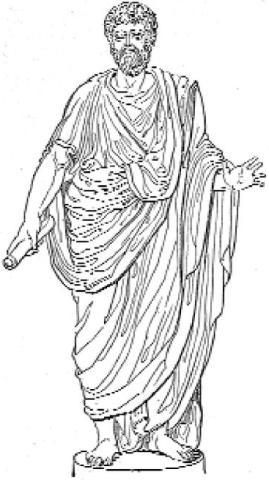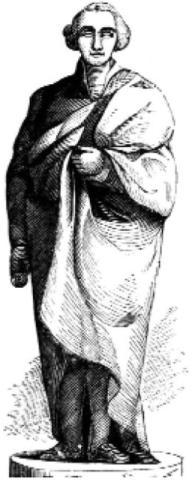intellectual life of Europe. Washington invoked a great spirit in the sky when he founded the city that would bear his name. And when Napoleon said he was guided by his star, this was no mere figure of speech; he was talking about the great spirit who showed him his destiny and made him invulnerable and magnificent. One of the aims of this book is to show that, far from being passing fads or unaccountable eccentricities, far from being incidental or irrelevant, these strange ideas formed the core philosophy of many of the people who made history — and perhaps more significantly, to show that
In the iconography and statuary of the ancient world, starting from the time of Zarathustra, knowledge of the secret doctrine of the Mystery schools was denoted by the holding of a rolled scroll. As we shall see, this tradition has continued into modern times, and today the public statues of the world’s towns and cities show how widely its influence has spread. There’s no need to travel as far as sites like Rennes-le-Chateau, Rosslyn Chapel or the remote fastnesses of Tibet to find occult symbols of a secret cult. By the end of this book the reader will be able to see that these traces lie all around us in our most prominent public buildings and monuments, in churches, art, books, music, films, festivals, folklore, in the very stories we tell our children and even in the names of the days of the week.
TWO NOVELS,
Some academics, for example Frances Yates at the Warburg Institute, Harold Bloom, Sterling Professor of Humanities at Yale, and Marsha Keith Suchard, author of the recent groundbreaking
The most secret teachings of the secret societies are transmitted only orally. Other parts are written in a deliberately obscure way that makes it impossible for outsiders to understand. For example, it


I have been looking for a concise, reliable and completely clear guide to the secret teachings for more than twenty years. I have decided to write one myself because I am convinced that no such book exists. It is possible to find self-published books and web sites that claim to do it, but, like collectors in any field, those who browse in bookshops on a spiritual quest soon develop a nose for ‘the real thing’, and you only have to dip into these books and sites to see there is no guiding intelligence at work, no very great philosophical training and very little hard information.
This history, then, is the result of nearly twenty years’ research. Books such as
But, crucially, I have been helped to understand these sources by a member of more than one of the secret societies, someone who, in the case of one secret society at least, has been initiated to the highest level.
I had been working for years as an editor for one London’s largest publishers, commissioning books on a wide range of more or less commercial subjects and sometimes also indulging in my interest in the esoteric. In this way I have met many leading authors working in the field. One day a man walked into my office who was clearly of a different order of being. He had a business proposition, that we should reissue a series of esoteric classics — alchemical texts and the like — to which he would write new introductions. We quickly became firm friends and spent a lot of time together. I found I could ask him questions about more or less anything and he would tell me what he knew — amazing things. In retrospect I think he was educating me, preparing me for initiation.
On several occasions I tried to persuade him to write these things down, to write an esoteric theory of everything. He repeatedly refused, saying that if he did ‘the men in white coats would come and take me away’, but I also suspected that for him to publish these things would be to break solemn and terrifying oaths.
So in a sense I have written the book I wanted him to write, based in part on the Rosicrucian texts he helped me to understand. He guided me, too, to sources to be found in other cultures. So as well as the cabalistic, hermetic and neoplatonic streams that lie relatively close to the surface of Western culture, there are also Sufi elements in this book and ideas flowing from esoteric Hinduism and Buddhism, as well as a few Celtic sources.
I have no wish to exaggerate the similarities between these various streams, nor is it within the scope of this book to trace all the ways that these myriad streams have merged, separated then merged again down the ages. But I will focus on what lies beneath the cultural differences and suggest that these streams carry a unified view of a cosmos that contains hidden dimensions and a view of life as obeying certain mysterious and paradoxical laws.
By and large the different traditions from around the world illumine one another. It is rather wonderful to see how the experiences of a hermit on Mount Sinai in the second century or of a medieval German mystic fit with those of a twentieth-century Indian swami. Because esoteric teachings are more deeply hidden in the West, I often use oriental examples to help understand the secret history of the West.
I do not intend to discuss potential conflicts between different traditions. Indian tradition places far more emphasis on reincarnation than the Sufi tradition, which speaks of only a few. So for the sake of the narrative I have compromised by including only a small number of reincarnations of famous historical personalities.
I have also made cavalier judgements as to which schools of thought and which secret societies draw on authentic tradition. So the Cabala, Hermeticism, Sufism, the Templars, the Rosicrucians, esoteric Freemasonry, Martinism, the theosophy of Madame Blavatsky and Anthroposophy are included, but Scientology, the Christian Science of Mary Baker Eddy, together with a whole slew of contemporary ‘channelled’ material, is not.
This is not to say that this book shies away from controversy. Previous attempts to identify a ‘perennial philosophy’ have tended to come up with collections of platitudes — ‘we are all the same under the skin’, ‘love is its own reward’ — which are difficult to disagree with. To anyone expecting something similarly agreeable, I must apologize in advance. The teaching I will be identifying as common to Mystery schools and secret societies from all over the world will outrage many people and fly in the face of common sense.
One day my mentor told me I was ready for initiation, that he would introduce me to some people.
I’d been looking forward to this moment, but to my surprise, I refused. No doubt fear played a part. I knew by then that many initiation rituals involved altered states of consciousness, even what are sometimes called ‘near- death’ experiences.
But it was partly also because I didn’t want to have all this knowledge given to me all of a piece. I wanted to continue enjoying trying to work it out for myself.
And neither did I want to take an oath that forbad me to write.

THIS HISTORY OF THE WORLD IS structured in the following way. The first four chapters will look at what happened ‘in the beginning’ as taught by the secret societies, including what is meant in the secret teaching by the expulsion from Eden and the Fall. These chapters will aim, too, to provide an account of the world-view of the secret societies, a pair of conceptual spectacles — so readers may the better appreciate what follows.

